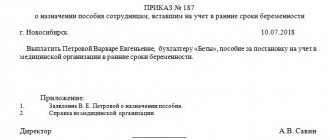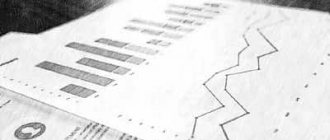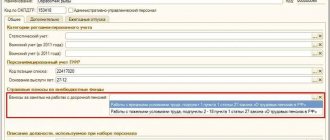Accounting for wages at an enterprise begins with documents that are the basis for calculating wages: staffing schedules, employment contracts, hiring orders, work orders, production accounting books, time sheets, incentive orders, etc.
Organizations can use unified forms of primary documents or use independently developed forms. The forms of documents used must be fixed in the accounting policies of the enterprise.
Salary accounting procedure
For each employee, the employer opens a personal card (form T-2) and a separate personal account (forms T-54 and T-54a).
Download employee personal card T-2 doc xls pdf
During the year, all types of charges and deductions are reflected on the account. This accounting for payroll and deductions allows you to determine the average earnings for vacation pay, sick leave, etc. A new personal account for an employee is opened annually.
Personal accounts are not required; small businesses and individual entrepreneurs are often limited to filling out a personal card and pay slips. Personal accounts or documents replacing them must be kept for 75 years.
Wages are calculated on the basis of time sheets, sick leave, work orders, orders for bonuses or deductions, etc. For calculations and accruals, pay slips (T-49 or T-51) are used.
Generate employee reporting online
A PAYMENT ACCOUNTING BOOK can be used instead of a payroll sheet.
Each sheet of this book is designed to account for wage calculations for 30 employees per month. Entries are made in the same order as when drawing up a payroll statement: the employee’s last name, first name, and patronymic are written down in the book once at the beginning of the year on the first sheet, i.e. For each employee, the position, personnel number, balance at the beginning of the period, calculation of wages (by type), deductions from wages (by type), balance at the end of the period are indicated. [p.165] Book of accounting for calculations of wages 165 [p.563] Record sheet of labor and work performed - records are kept for the team as a whole (form No. 66) record sheet of labor and work performed - personal account of each employee (form No. 66a ) tractor driver’s accounting sheet (form No. 67) - used to record work performed. The accounting sheet is issued for 10-15 days. The volume of work performed is recorded daily on a record sheet by the foreman (head of department) indicating the quality of the work. The data from the accounting sheets is recorded in the book of accounting for wage calculations, on the basis of the entries in which pay slips are compiled. [p.276]
According to the analytical account Share contributions take into account changes in the amount of share contributions. To record the movement of share contributions in journal order No. 13, one analytical account is opened. Accounting for the share contributions of each member of the collective farm is kept separately in the book of accounting for wage calculations (form No. 44). [p.339]
Along with the Book (journal) of accounting of business transactions to record settlements for wages with employees, for income tax with the budget, a small enterprise must also maintain a payroll record sheet in the form МБВ-8. [p.40]
With a simple form of accounting, small enterprises keep records of all transactions by registering them only in the Book (journal) of recording facts of economic activity in Form No. K-1. Along with this book, to record settlements for wages with employees of the enterprise, for income tax with the budget, a small enterprise maintains a payroll record sheet in Form No. B-8. [p.167]
An entrepreneur who uses the labor of hired workers on an ongoing basis to record wage calculations, along with the book, must also keep a payroll sheet, which is also a payment document and is intended for processing the payment of wages (Appendix 1). [p.64]
The self-instruction manual consists of several sections, which are divided into chapters with sequential numbering, are optimal in volume and include tasks for self-testing. First, the main theoretical issues of accounting and a number of its practical aspects are outlined, an example of accounting on synthetic accounts, drawing up a balance sheet and a working account plan is given. The following is specific material on a number of aspects of accounting in a small enterprise: accounting for funds, calculations for wages and social security, accounting for material assets, production and sales of products. The final sections of the book talk about the features of accounting for investments, capital, financial results, accounting for transactions in certain types of activities, financial statements and calculations. [p.3]
When checking the reliability of the final financial result indicator, the compliance of the financial results report data and their use (Form No. 2) with the General Ledger, order journals, and other accounting registers is established. This part of the work summarizes the results of monitoring the accounting of production costs and calculating the cost of finished products (works, services), payments in cash and in the form of non-cash payments, settlements for wages, with financial authorities, for off-budget payments, with debtors and creditors. [p.252]
Statement of calculations for wages Book of accounting of business transactions Cash book [p.167]
The book presents questions that are most often found in accounting exam papers. In particular, the basics of accounting, the requirements for it in the Russian Federation, international accounting standards, methods of accounting for funds and settlements, fixed assets, intangible assets, tangible assets, calculations for wages, production costs and finished products, capital, profits and loans of the organization. In addition, an idea of the regulatory framework for accounting in Russia is given. [p.5]
With a simple form of accounting, all business transactions are reflected (recorded) on accounts in the Book (journal) of accounting for business transactions. This book is structured in a similar way and is maintained in the same way as the Journal-Main in the Journal-Main accounting form. In addition to the book of accounting of business transactions, to record settlements with personnel for wages and other operational [p.185]
With an automated form of accounting, entries in the statements of debit and credit turnover are subject to control. In addition, the summary data is checked against the General Ledger (accounts 70 and 69). The balances on these accounts must be identical to the balance sheet indicators. No. 1 under Art. Settlements with creditors for wages and Settlements for social insurance and provision of section VI liabilities and under Art. Settlements with other debtors of section II of the asset (in terms of debts owed to workers and insurance bodies). [p.589]
In addition to this Book, in order to record settlements with personnel for wages and taxes on the budget for personal income, a small enterprise must also maintain a payroll record sheet (form No. B-8). [p.365]
You should begin checking settlements with personnel for wages by establishing the correspondence of the analytical accounting indicators in account 70 Settlements with personnel for wages with the entries in the General Ledger and the balance sheet as of the same date. To do this, you need to reconcile the balance of account 70 Settlements with personnel for wages on the first day in the General Ledger and in the balance sheet [p.230]
All operations are kept in the Book (journal) of accounting for these operations, and in terms of settlements with personnel for wages and with the budget, a payroll record sheet is opened (form N° B-8). [p.104]
In the book you will find comprehensive information on the issues of reflecting in accounting calculations with personnel for remuneration, as well as the payment of other types of income to them, for example, dividends, interest, amounts for compensation for harm caused to health. The procedure for remunerating workers when they manufacture products that turn out to be defective is also considered. [p.3]
The book records completed business transactions in chronological order, indicating the date and number of the document confirming the fact of the transaction (act, invoice, invoice, etc.), indicating the amount that corresponds to this transaction, and those accounting documents in which this amount will be paid. Along with the book of business transactions, to record settlements with employees for wages, an accountant of a small enterprise must keep a payroll record sheet in Form No. B-8. In the statement section Credit (accrued) are reflected [p.122]
Payroll payroll is used by individual entrepreneurs who employ hired workers, as well as by legal entities that maintain accounting records based on the book of business transactions. The payroll is intended to record settlements with employees for wages, as well as to determine the amounts of mandatory contributions and deductions to the State Social Insurance Fund, the Mandatory Medical Insurance Fund, the Employment Promotion Fund, the State Center for the Payment of Pensions, etc. in accordance with the established procedure from the amounts of remuneration of employees. The payslip is also a payment document and is intended for processing the payment of wages to employees of a small business entity. In the column “Accrued wages” the amounts accrued to employees for wages for work performed are reflected and at the same time deductions are made from the accrued amounts for wages (personal income tax, mandatory pension contributions and others in accordance with the legislation of the Republic of Kazakhstan) in the column “Withholding from wages." [p.92]
The third edition of the book sets out the basics of accounting, the procedure for maintaining accounting of fixed assets, inventories, labor and its payment in budgetary organizations, expenses for their maintenance, financing, funds, intradepartmental settlements for financing, settlements with other organizations and persons, funds and funds for the intended purpose, income, as well as the features of accounting for production costs, calculating costs, accounting for finished products and their sales. [p.636]
In addition, in the book of income and expenses there are separate columns in which income and expenses are indicated that are not accepted for calculating taxes. For example, expenses such as labor costs, as well as depreciation charges for fixed assets, intangible assets and low-value and wearable items are shown as expenses that are not accepted for tax calculation. [p.390]
Accounting for settlements with accountable persons is kept in a special statement (Table 3.5), similar to standard form No. VK-5. At the beginning of the month, data is entered into it about the debt of the cooperative to employees (for overspending on advances) and the debt of employees to the cooperative (for advances issued). After paying the employee for the overexpenditure, the amount given to him is recorded in the column Issued for reporting. Based on advance reports, fill in the columns Spent. As a result, they show the full amount of reimbursable expenses. In the Delivered to warehouse column, indicate the amount of funds received, if documents confirming their acquisition are attached to the report, and they contain a note about the material accounting being carried out in the books. In the column Written off for production (costs) the amount of material assets transferred directly to production, bypassing the warehouse, is entered, which must be confirmed by a receipt from the employee who received them. In the same column, travel expenses are recorded that comply with the standards approved by the Council of Ministers. In the column Written off from the wage fund, enter the difference between the total amount of funds spent (in the column Total spent) and the costs allocated to production (column Written off for production). In the column Returned to the cash register on the basis of a receipt order, the unspent balances of the advance payment handed over to the cash register are shown. [p.92]
The book examines in detail all sections on labor and wage accounting, provides recommendations on the use and completion of document forms for personnel accounting, covers issues of organizing remuneration, its forms and systems, organizing production accounting and calculating average earnings, the procedure for granting and paying for vacations and calculation of temporary disability benefits. [p.319]
Accounting for labor and wages at an enterprise should ensure operational control over the quantity and quality of labor, this is facilitated by the use of unified forms of primary documents that serve as the basis for settlements with employees. Resolution of the State Statistics Committee of the Russian Federation dated April 6, 2001 No. 26 approved unified forms of documentation for recording labor and its payment, and all of them are given in this book. [p.13]
Along with the book of business transactions to record settlements for wages with employees, the entity maintains a payroll sheet, similar to the payroll sheet used by individual entrepreneurs (clause 13). [p.66]
The state of accounting of payroll settlements with personnel is subject to mandatory verification. To do this, the compliance of the synthetic accounting of account 70 with the analytical accounting data for the same date is checked. Data from payroll sheets, turnover sheets for personal (analytical) accounts or corresponding machine diagrams are compared with the indicators of the General Ledger. When identifying discrepancies between analytical and synthetic accounting data, you should carefully check their reasons and find out whether it is caused by abuse. Leaving wage discrepancies undetected is unacceptable. If accounting for the Payroll Accounts account has been started and discrepancies in this account cannot be identified within the time period established for the audit, the auditor informs the management of the audited entity about this and requests an additional audit. [p.251]
Settlements with workers and employees for wages (on state farms) and with hired persons and collective farmers for wages and in-kind payments (on collective farms) are carried out in payroll statements (form No. 73). The procedure for compiling statements is similar to the procedure for compiling at industrial enterprises. After verification, the final data of payroll statements are recorded in the Summary of data on settlements with workers and employees (collective farmers) - development table No. 21. In the summary from payrolls or the book of accounting for settlements with workers and employees, the debt to the beginning of the month for the farm is transferred or for workers and employees (hired persons on collective farms). The expanded balance of account No. 70 Settlements with workers and employees (Calculations for wages - on collective farms) at the beginning of the month must be reconciled with the General Ledger. [p.279]
Synthetic accounting for account 70 “Settlements with personnel for remuneration” is maintained in the General Ledger in a generalized form and in monetary terms, and analytical accounting is maintained in payroll statements, which should be replaced with personal accounts of employees. [p.394]
Along with the Book (journal) of accounting for business transactions, a small enterprise must keep a payroll record sheet in Form B-8 to record settlements with employees for wages and settlements with the budget for income tax. [p.96]
Pay systems
There are three main remuneration systems :
- tariff;
- tariff-free;
- mixed.
The tariff system is a set of standards with the help of which the wages of workers of different categories are differentiated.
The tariff system of remuneration consists of several elements (Fig. 1):
Figure 1. Elements of the tariff system of remuneration
A tariff-free wage system implies the non-use of guaranteed tariff rates and official salaries. With a non-tariff wage system, an employee’s salary depends on the final results of the work of the entire division of the organization and represents a share in the wage fund earned by the entire team. The share of an individual employee's salary is determined based on the employee's qualifications and labor participation.
Too lazy to read?
Ask a question to the experts and get an answer within 15 minutes!
Ask a Question
The use of a tariff-free system is advisable if it is possible to take into account the labor results of each employee. This system has a positive effect on the overall interest of the team and each employee individually.
Forms of remuneration
There are two forms of remuneration : time-based and piece-rate, which in turn are divided into several forms.
- Time-based form of remuneration.
- Simple time payment. This type of payment is made for a certain amount of unworked time and does not depend on the quantitative characteristics of the work. It is calculated by multiplying the hourly or daily rate by the number of hours or days worked. If the employee has a salary, then wages are calculated based on the time worked based on the monthly salary.
Time-based bonus wages. This form of payment implies that the bonus specified in the employment agreement with the employee or enshrined in other internal documents of the organization is added to the time payment calculations.
- Piece wages.
- Direct piecework wages. Carried out on the basis of established piece rates per unit of products or work produced by the employee. This form of remuneration also takes into account the qualifications of the employee.
Piece-bonus form of remuneration. Provides for the accrual of bonuses for exceeding the production plan or achieving certain quality indicators of the work performed
- Piece-progressive form of remuneration. The essence of this form of remuneration is to increase payment for the production of products or work in excess of the established norm.
- Indirect piecework form of remuneration. Produced for workers in auxiliary production as a percentage of the wages of workers in main production (adjusters, assemblers, assistant foremen, etc.).
In practice, mixed forms of remuneration are often used. This applies, first of all, to workers combining several positions at one enterprise.
- Accordal payment. It is used to calculate payment for a set of works or the production of a certain volume of products or work, and not for a specific production operation.
Finished works on a similar topic
- Coursework Types, forms and systems of remuneration, the procedure for calculating it 490 rubles.
- Abstract Types, forms and systems of remuneration, the procedure for calculating it 220 rubles.
- Test work Types, forms and systems of remuneration, the procedure for calculating it 230 rubles.
Receive completed work or specialist advice on your educational project Find out the cost
Salary deductions
Personal income tax, alimony, professional contributions, amounts for unworked vacation days upon dismissal of an employee, and other amounts under writs of execution, at the decision of the employer, at the request of the employee, are withheld from wages. Accounting depends on their type - wages accrued for the month are reduced by the amount of deductions. This is reflected by posting to the debit of account 70.
The amount of deductions is limited (Article 138 of the Labor Code of the Russian Federation) and in general should not exceed 20% of the amount due to the employee. Mandatory deductions (based on writs of execution) can amount to up to 50% of the amount paid. In exceptional cases, deduction of up to 70% is allowed, for example, when paying alimony for minors or compensation for losses caused by a crime.









